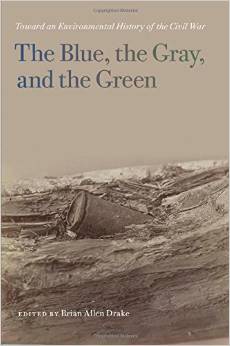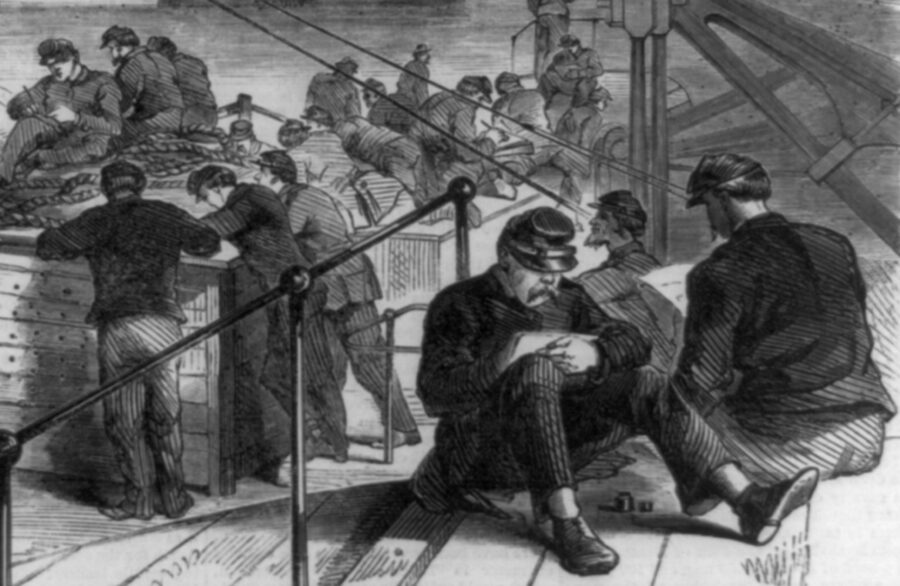The Blue, the Gray, and the Green: Toward an Environmental History of the Civil War edited by Brian Allen Drake. University of Georgia Press, 2015. Paper, IBSN: 978-0820347158. $22.95.
 A skeptic, grasping for a metaphor to describe the fecundity of Civil War history, might be tempted to borrow from Scottish geologist Charles Lyell’s 1846 description of an eroded field in Georgia. There, Lyell found a wide gully, fifty-five feet deep and 900 feet in length. That skeptic would likely choose a different metaphor after reading The Blue, the Gray, and the Green, edited by Brian Allen Drake. These essays demonstrate that the environmental history of the Civil War is growing not unlike Virginian and North Carolinian bright-leaf tobacco—a crop that flourished in soil previously deemed unfit for cultivation.
A skeptic, grasping for a metaphor to describe the fecundity of Civil War history, might be tempted to borrow from Scottish geologist Charles Lyell’s 1846 description of an eroded field in Georgia. There, Lyell found a wide gully, fifty-five feet deep and 900 feet in length. That skeptic would likely choose a different metaphor after reading The Blue, the Gray, and the Green, edited by Brian Allen Drake. These essays demonstrate that the environmental history of the Civil War is growing not unlike Virginian and North Carolinian bright-leaf tobacco—a crop that flourished in soil previously deemed unfit for cultivation.
The ten central essays in The Blue, the Gray, and the Green provide insight into exciting new research taking place in Civil War history. They are organized under three broad themes: the impact of nature on the Civil War; the human perception of nature; and the interaction or “hybridity” between humans and the environment. Several contributors, including Lisa M. Brady and Megan Kate Nelson, have already written monographs on this subject, but they present new research in this volume. Other contributors, such as Drew A. Swanson and Aaron Sachs, derive their essays from upcoming, new, or recent works on nineteenth-century environmental history, of which the Civil War is just one component. The common ground, explicit in some essays and implicit in others, is a search to answer how and to what extent looking to nature changes our understanding of Civil War history.
The first four essays suggest that overlooking nature’s hand ignores important influences in human history. Paying attention to nature helps to untangle the contingencies of historical experience and causation. In a chapter on climate and weather, Kenneth W. Noe examines how nature affected military outcomes and includes an appendix of eighty-two battles, ranking them into five categories based on the impact of weather. Megan Kate Nelson follows this broad essay with a close examination of a Union military defeat in 1861, arguing that the natural forces of New Mexico shaped the decisions—and ultimately the surrender—of Maj. Isaac Lynde and six hundred soldiers from the 7th U.S. Infantry. Focusing on nature also recovers much of the lived experience of war. In an examination of the exchanges between people and nature in or from Yancey County, North Carolina, Timothy Silver provides an example of how historians might “ensure that the portmanteau biota get equal time with humans” (53). One of the important stories Silver recovers is the effect of war and disease on domesticated and wild animals. Lastly, Kathryn Shively Meier demonstrates that historians have looked at “straggling” too much through the eyes of military officers. From the perspective of soldiers, straggling was essential “self-care” in unforgiving environments that kept them out of hospitals.
The middle two chapters explore the effect of the Civil War on the ways in which people perceived wilderness. Aaron Sachs asserts that the Civil War reshaped how people perceived and valued natural resource stewardship. Once a symbol of necessary and positive progress, tree stumps came to symbolize an unnatural, premature, wasteful loss of wilderness, similar to the human stumps and empty sleeves of war. Equally provocative, John C. Inscoe highlights how the context of the Civil War inverted perceptions of the Appalachian Mountains. Antebellum perceptions of a dark, howling wilderness in the Appalachian Mountains gave way to a peculiar moral high ground during and after the Civil War. In particular, the image of Appalachian wilderness as a southern refuge for Union dissenters and runaway slaves became a theme in fiction and nonfiction.
As a group, the remaining chapters on the hybridity between humans and nature are more diverse. Lisa Brady repurposes Prussian military theorist Carl von Clausewitz’s concept of friction—or human unpredictability—to encapsulate the uncertainties of nature. She explores the phenomenon known as an “acoustic shadow” and how military leaders responded to the uncertainty of relying on listening for knowledge about military events. Two chapters on agriculture indicate the adaptability of land use to specific ends. Drew Swanson narrates how Piedmont farmers developed “bright leaf” tobacco for cultivating in soil ill-suited for other crops and resisted government pressure to switch to food production. Focusing on the conflict between landlords and laborers during Reconstruction, Timothy Johnson demonstrates how the slave regime became the fertilizer regime through debt peonage. The final essay, by Mart A. Stewart, returns to the lived experience of war and nature by comparing how civilians, soldiers, and slaves engaged their environments through walking, running, and marching.
Brian Drake promises in the introduction that this collection is a “methodological smorgasbord” for ways in which environmental history is contributing to the reshaping of Civil War history. This volume does more than fulfill that promise. If anything, Drake’s introduction, Paul S. Sutter’s cautionary “Waving the Muddy Shirt” epilogue, and several of the contributors seem too restrained in touting the freshness of their common environmental lens and diverse findings. The persistent fear seems to be that the environment is too obvious of a factor. It is not, after all, breaking new ground to say that the Civil War was fought outdoors. Yet if Civil War historians want to discover how participants in the past perceived a war fought outdoors, it is past time to immerse Civil War history in nature. Ranging from localized, heavily empirical analysis to broad and imaginative explanations of cultural change, these essays are a starting point for doing just that.
Evan A. Kutzler received his Ph.D. in U.S. History from the University of South Carolina in spring 2015.
